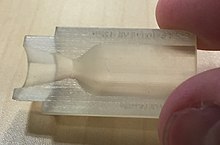Cold gas engine
A cold gas engine is a rocket engine that uses high pressure gas as a support mass . In contrast to other types of engines, the gas stored at room temperature is not heated, but simply ejected and expanded through a thrust nozzle . Common gases are air , nitrogen , helium or argon , and sometimes butane . Upper stages of launch vehicles sometimes use the gas mixture in the fuel tank for attitude control .
Cold gas engines have been used as a reaction control system for attitude control since the beginning of space travel over 70 years ago ; early spacecraft only used these engines. The most important application is still the position control.
The components used are simple and consist of one or more pressure vessels for the gas, several thrust nozzles, electrically operated valves , a pressure regulator and access points for filling and releasing the gas. Since the gas is under very high pressure (typically 300–1000 MPa or 3000–10,000 bar ), the tanks (usually made of titanium or composite materials ) must be built with correspondingly strong walls, often with thick walls. Nozzles, valves and gas lines can be made of aluminum or plastic. The gas nozzles themselves are operated at pressures of around 1.5–5 bar. The functional status of the system is monitored with pressure and temperature sensors while filling up or releasing gas and during operation. By measuring the pressure and temperature in the gas tank and knowing its volume, the remaining fuel supply can be calculated using the gas equation .

Cold gas systems are simple, relatively cheap and safe to use. They have been used successfully in space travel for a long time and are extremely reliable. The gases used are non-toxic, chemically pure and do not leave any deposits on sensitive surfaces of the spacecraft (e.g. mirrors or sensors). The gas nozzles can be pulsed as required for position control. Due to their low thrust, they can be controlled with very fine resolution and thus enable extremely high accuracy of spatial alignment.
The disadvantages are the low specific impulse of only around 40–120 s (engines with monergolic fuels typically achieve 180–245 s, diergole fuel combinations 230–325 s), the high weight of the systems and their relatively large volume. A common satellite can achieve a speed change of about 74 m / s with a cold gas system .
Web links
Individual evidence
- ^ A b c d George P. Sutton, Oscar Biblarz: Rocket Propulsion Elements . 9th edition. John Wiley & Sons , Hoboken 2017, ISBN 978-1-118-75388-0 , pp. 304 .
- ^ Ernst Messerschmid, Stefanos Fasoulas: Space systems . 5th edition. Springer Vieweg , Berlin / Heidelberg 2017, ISBN 978-3-662-49637-4 , p. 184 , doi : 10.1007 / 978-3-662-49638-1_5 .
- ^ A b c George P. Sutton, Oscar Biblarz: Rocket Propulsion Elements . 9th edition. John Wiley & Sons , Hoboken 2017, ISBN 978-1-118-75388-0 , pp. 266-267 .
- ↑ George P. Sutton, Oscar Biblarz: Rocket Propulsion Elements . 9th edition. John Wiley & Sons , Hoboken 2017, ISBN 978-1-118-75388-0 , pp. 8 .
- ↑ George P. Sutton, Oscar Biblarz: Rocket Propulsion Elements . 9th edition. John Wiley & Sons , Hoboken 2017, ISBN 978-1-118-75388-0 , pp. 194 .
- ↑ a b c d Hans Dieter Schmitz: Satellite Propulsion . In: Wilfried Ley, Klaus Wittmann, Willi Hallmann (Eds.): Handbook of Space Technology . John Wiley & Sons , Chichester 2009, ISBN 978-0-470-69739-9 , pp. 302-305 , doi : 10.1002 / 9780470742433.ch4 .
- ↑ George P. Sutton, Oscar Biblarz: Rocket Propulsion Elements . 9th edition. John Wiley & Sons , Hoboken 2017, ISBN 978-1-118-75388-0 , pp. 131 .
- ^ A b Hans Dieter Schmitz: Satellite Propulsion . In: Wilfried Ley, Klaus Wittmann, Willi Hallmann (Eds.): Handbook of Space Technology . John Wiley & Sons , Chichester 2009, ISBN 978-0-470-69739-9 , pp. 313-315 , doi : 10.1002 / 9780470742433.ch4 .
- Jump up ↑ DG Chavers, BA Cohen, JA Bassler, MS Hammond, DW Harris, LA Hill, D. Eng, BW Ballard, SD Kubota, BJ Morse, BD Mulac, TA Holloway, CLB Reed: Robotic Lunar Landers for Science and Exploration . In: NASA (ed.): 7th International Planetary Probe Workshop (IPPW-7) . June 12, 2010, p. 10 (English, ntrs.nasa.gov ).
- ↑ George P. Sutton, Oscar Biblarz: Rocket Propulsion Elements . 9th edition. John Wiley & Sons , Hoboken 2017, ISBN 978-1-118-75388-0 , pp. 300 .
